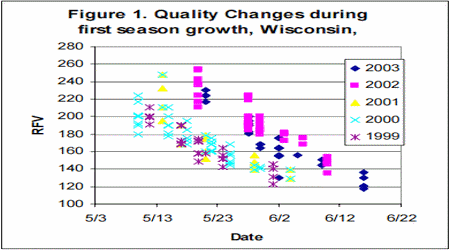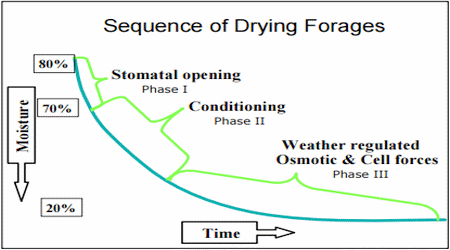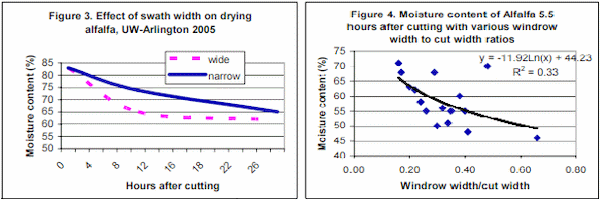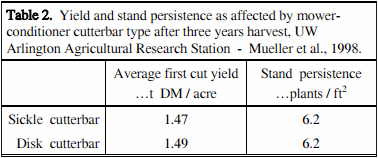Introduction
From the moment the alfalfa is cut until it is delivered to the animal, biological and mechanical processes take place that decrease quantity and nutritional quality of alfalfa. Our goal is to conserve the digestible fiber, protein, and energy in the forage and to maintain protein in a form that can be effectively utilized by the ruminant.
The approach is to harvest at the correct stage for the desired quality, to dry hay as fast as possible to minimize respiration, bleaching and rain damage, and then to harvest avoiding leaf and dry matter loss.
Discussion
Harvesting at Correct Stage
Forage quality generally declines as the alfalfa plant matures. We want to wait as long as we can to harvest because each day adds 100 to 200 lb/acre additional dry matter to total yield. However, waiting too long will cause the forage quality to be lower than we want or lower than we can market. Figure 1 shows that the change in alfalfa quality is pretty linear near harvest within a year but that quality can be very different at the same date in different years. First cutting alfalfa is the most variable in quality because the relatively long spring period can have vastly different effects on plant morphology and composition depending on temperature and sunlight. This means that stage of maturity is not a good indicator of when to take first cutting. Neither is calendar date, as the graph indicates. Growing degree days have had success in some regions but not in others. The major tool that seems to work is the forage quality stick. This stick uses plant height and stage of alfalfa maturity to estimate forage quality. Evidence from many regions of the U.S. indicates that it will give answers very similar to sampling from the field and getting a laboratory analysis but saving the time and expense. The new alternative will be in-line forage analysis by NIR which is becoming available for some choppers in 2007 and will likely be available for balers in the not too distant future.

The Hay Drying Process
If we understand and use the biology and physics of forage drying properly, not only does the hay dry faster and have less chance of being rained on, but the total digestible nutrients (TDN) of the harvested forage are higher. As mowing and conditioning equipment has evolved, some of the basic drying principles of forage have slipped by the wayside and we need to review them.
The general pattern of drying forages is shown in the figure at right. Forage has 75 to 80 percent moisture when cut and must be dried down to 60 to 65% moisture content for haylage or down to 14 to 18% moisture content for hay (lower figures for larger bales).
The first phase of drying is moisture loss from the leaves through the stomates. Stomates are the openings in the leaf surface that allow moisture loss to the air to cool the plant and carbon dioxide uptake. Stomates open in daylight and close in dark and when moisture stress is severe. Cut forage laid in a wide swath maximizes the amount of forage is exposed to sunlight. This keeps the stomates open and encourages rapid drying which is crucial when plants are first cut because plant respiration continues after the plant is cut. Respiration is the breakdown of starch and sugars. It is highest at cutting and gradually declines until plant moisture content has fallen below 40% (Rotz and Muck, 1994). Therefore rapid initial drying to lose the first 15% moisture will reduce the loss of starches and sugars and preserve more total digestible nutrients in the harvested forage. This initial moisture loss is not affected by conditioning.

The second phase of drying (II) is moisture loss from both the leaf surface (stomates have closed) and from the stem. At this stage, conditioning can help increase drying rate, especially on the lower end.
The final phase of drying (III) is the loss of more tightly held water, particularly from the stems. Conditioning is critical to enhance drying during this phase. Conditioning to break stems every two inches allows more opportunities for water loss since little water loss will occur through the waxy cuticle of the stem.
Understanding these principles will allow us to develop management practices in the field that maximize drying rate and TDN of the harvested forage. The first concept is that a wide swath immediately after cutting is the single most important factor maximizing initial drying rate and preserving of starches and sugars. In a trial at the UW Arlington Research Station (Figure 3) where alfalfa was put into a wide swath, it reached 65% moisture in about 10 hours and could be harvested for haylage the same day as cutting. The same forage from the same fields put into a narrow windrow was not ready to be harvested until later the next day!
In fact, a wide swath may be more important than conditioning for haylage.
The importance of a wide swath is supported from drying measurements taken at the Wisconsin Farm Technology Days in 2002 (figure 4) where different mower-conditioners mowed and conditioned strips of alfalfa and put the cut forage in windrow widths of the operators choice. Moisture content of the alfalfa was measured 5.5 hours after mowing. Each point is a different machine that included sickle bar and disc mowers and conditioners with, steel, rubber or combination rollers. Across all mower types and designs, the most significant factor in drying rate was the width of the windrow.
In figure 4, note the one outlying point at 70% moisture content and a windrow width/cut width ratio of 0.48. This shows how much drying can be slowed by improper adjustment of the conditioner.
We used to make wide swaths in the past but have gradually gone to making windrows that are smaller and smaller percentages of the cut area as mowers have increased in size. Generally, as mowers have gotten bigger, the conditioner has stayed the same size, resulting in narrower windrows. There is some variation among makes and models and growers should look for those machines that make the widest swath.
Putting alfalfa into wide swaths (72% of cut width) immediately after cutting results improved quality of alfalfa haylage compared to narrow windrows (25% of cut width) in a study at UW Arlington Research Station in 2005 (Table 1). Alfalfa was mowed with a discbine, conditioned, and forage was sampled two months after ensiling in tubes. The alfalfa from the wide swaths had 2.3% less NDF, and 1.8% more NFC. The NFC difference is both a quality and yield difference as the 1.8% loss in narrow windrows was to respiration where starch is changed to carbon dioxide and lost to the air. The haylage from the wide swath had almost 1% more TDN and more lactic and acetic acid. The higher acid content would indicate less rapid spoilage on feedout and the overall improved forage quality would be expected to result in 300 lbs more milk per acre.
Some are concerned that driving over a swath will increase soil (ash) content in the forage. In table 1, the ash content of haylage from wide swath alfalfa was actually less than from narrow windrows. While narrow windrows are not usually driven over, they tend to sag to the ground causing soil to be included with the windrow when it is picked up. Wide swaths tend to lay on top of the cut stubble and stay off the ground. Further, driving on the swath can be minimized by driving one wheel on the area between swaths and one near the middle of the swath where cut forage is thinner.
With rapid drying, TDN and dry matter loss can be 5%, but it can be excessive when drying conditions are poor.
Mowing Equipment
The primary mower types are sickle and rotary mowers. The type of mower used has little effect on drying, mowing losses and the resulting forage quality. In the 1980’s, the disk cutterbar machines were introduced into the North American market. These machines experienced some initial resistance because some early models were known to have some very expensive failures of the cutter gear bed when large field obstructions were hit and early models did not include a conditioner.

Manufacturers now offer disk mowers with segmented module gear beds and overload protection devices to reduce repair costs when damage occurs to the cutterbar. These new designs tend to isolate damage when an obstruction or rock is hit, greatly reducing the risk of large repair costs. Some alfalfa producers have expressed concern that the impact cutting of the disk cutterbar can cause damage to the plant crown that will lead to lower yield and stand persistence. Research on this subject showed that neither yield nor stand persistence was affected by the type of cutting system (table 2).
This does not mean that mean that disk cutterbar mower-conditioners can’t damage both alfalfa and grass crops. Care must be taken to set the cutterbar cutting-angle so that scalping does not occur because, unlike a sickle cutterbar, the disk cutterbar will easily scalp without hesitation or plugging. The condition of the knives must also be checked regularly because the disk cutterbar will cut even if the knives are incredibly dull and worn. Dull and worn knives could produce a more ragged cut that might lead to plant health problems.
Rotary mowers have a higher power requirement per length of cutterbar and thus require a larger tractor and more fuel to operate. With a higher mowing capacity though, less time is required offsetting some of the increased fuel use and reducing the labor required. Even though the purchase price of rotary mowers is higher for a given width of cut, the overall cost of mowing is similar between these major mower types. The major consideration is that maintenance is much less for disc mowers than for sickle mowers.
It should be noted that different knives are available for disc mowers. Curved and angled knives tend to pick up downed forage better. However, then tend also to pick up more ash when the soil is dry. For general purposes a flat horizontal knife is best.
Conditioning to speed drying
Mechanical conditioning treatments used to speed drying can be categorized as either roll or flail conditioners. Rolls smash and/or break the plant stems, and flails abrade the waxy surface of the plant and break stems. Both processes can improve drying, but for alfalfa, roll devices are more effective with less field loss (Rotz, 1995). Some roll designs are promoted for faster drying, but field and laboratory studies consistently show little or no difference in the drying of alfalfa or grass treated with commonly used crushing roll designs. Roll conditioning is most effective on a thick stemmed crop such as an early cutting of alfalfa.
Adjustment of the roll conditioning mechanism can effect drying. Both roll clearance and pressure often can be adjusted. Roller clearance is often overlooks but minimum clearance must be maintained. If the clearance becomes too close, excessive damage and loss of plant particles occurs. With too much clearance, plant material flows between the rolls with little crushing. (See end of article for conditioner clearance adjustment.) Too little or too much pressure on the rolls has similar effects. On flail type conditioners, the clearance between the rotating flails and a stationary bar can be adjusted to control the amount of breaking and abrasion that occurs.
Flail conditioners were originally developed to condition grasses. Grasses are difficult to condition with rolls because it is almost impossible to achieve a small enough roll clearance to crush the fine stems and leaves of most grasses. Flail conditioners can now can be used to condition alfalfa or other leafy crops. Rotor speed is typically slowed about 30% to reduce the impact effect when conditioning alfalfa. There is considerable debate as to the effectiveness of impeller conditioners with alfalfa. Some producers report faster drying rate while others are convinced otherwise. Side by side tests have shown impellers produced a faster drying rate with a higher leaf loss (Greenlees et al., 2000). The position of the conditioning hood is critical to the level of conditioning and producers need to make sure that this adjustment is properly made. There is speculation that some of the drying rate improvements that users of impellers have experienced may be due to the fact that roll clearance was not properly maintained on their previous machines.

Dry matter losses and the associated nutrient changes caused or promoted by conditioning increase with crop maturity and the severity of conditioning. Although more severe conditioning can provide faster field curing, harvest losses are generally greater. Normally moderate conditioning is recommended to obtain adequate drying with relatively low loss (1-2% of yield). This relatively low loss has little effect on forage quality.
Within the last few years, there has been a new intensive conditioning system offered as a replacement for the conventional rolls on windrowers and mower-conditioners (Circle-C Equipment, Hermiston, OR 97838, 1-800-367-1847). This system has a set of non-intermeshing rubber rolls that operate at very small or virtually zero clearance. Tests conducted by various researchers have found a roughly 10 to 15% increase in the drying rate compared to conventional conditioning. That translates to the crop achieving baling moisture 1½ to 2½ hours sooner than conventional practices.
Considerable research and development has been devoted to “intensive conditioning” or “macerating” over the past 20 years. Several machine designs have been evaluated, which shred the plant material to allow more rapid field curing. Drying rate is increased by 25 to 150% with the fastest drying in thin wide swaths under good drying weather on the experimental machines. Power requirement is at least twice that of a mower-conditioner, and field losses can be very high. To reduce losses, various methods have been used to press the shredded material into a mat. When rain occurs, losses can still be up to four times greater than regular conditioning.
A new intensive conditioner has been introduced that claims it conditions the stem by “macerating” (AgLand Equipment, Arborg, Manitoba, Canada). This trail-behind pull-type machine has a set of intermeshing rubber rolls that feed a second set of serrated steel rolls. The serrated steel rolls operate at small clearance and differential speed. They are intended to nick and scratch the stem as a means of conditioning. It apparently increases drying rate, though not as much as some of the experimental macerators because of design concessions made to get throughput.
A chemical conditioner or drying agent can be sprayed on alfalfa at mowing to help speed drying (Rotz, 1995). The chemical affects the waxy surface of the plant to allow easier moisture loss. The most effective treatment is a potassium and sodium carbonate based solution. This treatment has only been effective on legume forage crops and it is most effective on cuttings harvested in the summer months. The treatment can double the drying rate of the crop when used under good drying conditions with the crop dried in a relatively thin swath. On the average, this increase reduces field-curing time about half a day. Faster drying reduces respiration loss and occasionally avoids rain damage. The major deterrent to this process has been the need to handle large quantities of the liquid treatment (about 30 gallons of solution per acre).
Swath manipulation to speed drying
As forage dries in the field, the top of the swath dries more rapidly than the bottom. Manipulation of the swath can speed the drying process by moving the wetter material to the upper surface (Rotz, 1995). Swath manipulation can also improve drying by spreading the hay over more of the field surface, increasing exposure to the radiant solar energy and drying air. There are three operations used in haymaking to manipulate the swath: tedding, swath inversion, and raking.
Tedding can be used anytime during field curing, but it is best to do so before the crop is too dry (above 40% moisture content). The stirring or fluffing of forage typically reduces field-curing time up to half a day. Tedders are sometimes used to spread a narrow swath formed by the mowerconditioner over the entire field surface. When done soon after mowing, the average field curing time is reduced up to 2 days compared to drying in a narrow swath and dry matter losses are minimal. If done longer than 24 hours after mowing drying time is less reduced and dry matter losses are increased. In addition to speeding drying, tedding also tends to create more uniform drying, so wet spots in the swath are reduced.
Disadvantages of tedding include increased losses and increased fuel, labor, and machinery costs. When tedding is done on a relatively wet crop (above 50% moisture), the resulting loss is less than 3%; however, applied late in the drying process, the loss can be more than 10%. Tedding will also increase raking loss. When a light crop (less than 1 ton/acre) is spread over the field surface, raking loss can be more than double that when raking narrow swaths. Spreading the hay may promote bleaching of hay color. Bleaching does not affect the nutritive value of hay but often affects the market value. When the costs of performing the tedding operation are compared to the benefit received, routine use of tedding is difficult to justify, particularly for alfalfa. Occasional use under difficult drying conditions may bring greater economic benefit.
Swath inversion machines have been used that gently lift and invert the swath. Exposing the wetter bottom of the swath speeds drying, and reduces the average field-curing time a few hours. Swath inversion is not as effective for improving drying as tedding, but shatter loss is very low. With less drying benefit, there is less potential for reducing rain and respiration losses. The added labor, fuel and machinery costs of the operation are generally greater than the benefit received.
Raking is another form of swath manipulation
Raking tends to roll the wetter hay from the bottom of the swath to the outer surface of the windrow, which improves drying. Following the initial improvement, the increase in swath density can reduce drying rate, so the crop moisture content at raking is important. Raking also causes dry matter and quality loss, and the loss is related to crop moisture (2% when wet to 15% in very dry crop of alfalfa). The best moisture content to rake for low loss and good drying is 40%. In dry weather periods, hay can be raked in the evening or early morning when leaves are moist and less prone to shatter. Raking at the proper time can reduce fieldcuring time a few hours to allow an earlier start at baling.
The best recommendation is to dry hay rapidly using mechanical conditioning. High yielding crops should be spread in wide swaths. Tedding may be useful in drying grass crops, but it should be avoided with alfalfa, particularly after the crop has partially dried. Raking can be used to improve harvest capacity. A substantial economic benefit can often be obtained by rolling swaths together to allow large balers or forage harvesters to operate more efficiently. The most economical harvesting comes from harvesting that most nearly match the baler or chopper capacity.
Merging swaths or windrows, where the forage is picked up off the ground and conveyed across to be put into a windrow, has been introduced. Mergers move hay with minimal dry matter loss and pick up minimal soil so that forage ash content does not increase. Mergers may be economical where windrow size is increased sufficiently to reduce harvesting time and labor.
Baling High Moisture Hay
Another option for shortening the field curing time is to bale hay before it is fully dry. Balers are available which produce bales of a wide variety of shapes and sizes and the safe moisture content for hay storage varies with size. Baling at the appropriate moisture content without special treatment is important for minimizing harvest loss and maintaining quality following harvest. For low-density (small rectangular and most large round) bales, the recommended baling moisture content is about 18%. For high-density bales (large rectangular), drier hay in the range of 12 to 14% is recommended to improve preservation. Bales can be baled wetter with proper treatment very successfully.
Respiration of microorganisms (bacteria, fungi, and yeasts) on hay wetter than recommended for storage causes heating and further DM and nutrient loss during storage (Rotz and Muck, 1994). Greater heating occurs as hay density increases, particularly in large bales. Dry matter loss during the first month of storage varies from 1 to 8% increasing with hay moisture content. For hay containing more than 25% moisture, excessive loss and even spontaneous combustion can occur.
Many types of mold have been identified in hay (Actinomycetes; Aspergillus glaucus, flavus, fumigatus, repens, and versicolor; Emericella nidulans and rugulsa; Eurotium amstelodami; Fusarium; Mucor; Penicillium aufantiogriseum; and other unidentified yeasts). The greatest diversity of molds occurs in unheated hay. It is important to recognize that, while most are harmless most of the time, some can produce toxins to both humans and animals. Animal affects include reduced feed intake and reduction of immune system which can result in increased milk cell count and predispositioning to numerous other diseases. The major factor affecting mold species dominance is the peak storage temperature.

Field losses can be reduced by baling at a moisture content near 25% and using a preservative or wrapping hay bales in plastic. Baling moist hay may reduce raking and baling losses providing an increase in harvested yield (about 7%) and harvested quality. The only proven effective preservative is propionic acid (buffered recommended). Purchased preservatives should be checked for concentration of active ingredient (propionic acid) and product added with increasing rates at the hay is wetter above the recommended storage moisture for the bale type.
Another newer alternative is to wrap bales in plastic. Bales can be wrapped individually or in a long tube. Bales should be wrapped within 24 hours of baling and with 6 layers or more of plastic to prevent oxygen diffusion into the bale.
In summary, the best management practices associated with harvesting quality forage are to keep dense, high yielding stands, mow at appropriate time, to dry as quickly as possible, preserving as many leaves as possible and to harvest at the appropriate moisture content for storage.
Presented at Western Alfalfa Symposium, Reno, NV 11-13 December, 2006.
References
Greenlees, W.J., H.M. Hanna, K.J. Shinners, S.J. Marley, and T.B. Bailey. 2000. A comparison of four mower-conditioners on drying rate and leaf loss in alfalfa and grass. Applied Engineering in Agriculture. 16(1):15-21.
Mueller, D.H., D.J. Undersander and D.L. Frye. 1998. Disc and sickle mower-conditioners affect on stand persistence and yield. Proceeding of WI Forage Council 22nd Annual Forage Production and Use Symposium.
Rotz, C.A. and R.E. Muck. 1994. Changes in Forage Quality during Harvest and Storage. In: Forage Quality, Evaluation, and Utilization, Eds. G.C. Fahey, Jr. et al. Am. Soc. Agron., Madison, WI. pp. 828-868.
Rotz, C.A. 1995. Field Curing of Forages. In: Post-Harvest Physiology and Preservation of Forages. CSSA Special Publication no. 22. Crop Sci. Soc. Agron. and Am. Soc. Agron., Madison, WI. pp. 39-65.















.jpg&w=3840&q=75)